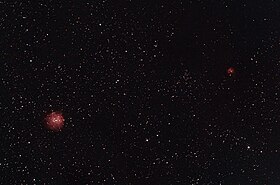NGC 1624-2
 NGC 1624-2 is the brightest star at the centre of NGC 1624 on the left of this image spanning about one degree. | |
| Observation data Epoch J2000 Equinox J2000 | |
|---|---|
| Constellation | Perseus |
| Right ascension | 04h 40m 37.276s[1] |
| Declination | 50° 27′ 41.04″[1] |
| Apparent magnitude (V) | 11.57[2] |
| Characteristics | |
| Evolutionary stage | O-type star |
| Spectral type | O7f?cp[3] |
| U−B color index | −0.57[2][4] |
| B−V color index | 0.9[2] |
| Astrometry | |
| Proper motion (μ) | RA: 0.025[1] mas/yr Dec.: 0.108[1] mas/yr |
| Parallax (π) | −0.3521 ± 0.1716 mas[1] |
| Distance | 5,152.3[5] pc |
| Details | |
| Mass | 34[5] M☉ |
| Radius | 10[5] R☉ |
| Luminosity | 126,000[5] L☉ |
| Surface gravity (log g) | 3.55[1] cgs |
| Temperature | 35,000[5] K |
| Metallicity [Fe/H] | +0.07[1] dex |
| Rotation | 315.98 d[6] |
| Rotational velocity (v sin i) | <3[5] km/s |
| Other designations | |
TYC 3350-255-1, ALS 18660, 2MASS J04403728+5027410 | |
| Database references | |
| SIMBAD | data |
NGC 1624-2 is a massive O-type star located in the star cluster NGC 1624, in the constellation of Perseus, about 16,800 light years away. NGC 1624-2 is notable for being most strongly magnetised O-type star known,[6] with a magnetic field strength of 20 kG, or about 20,000 times the Sun's magnetic field strength.[5] It hosts a large and dense magnetosphere, formed from the interaction between its very strong magnetic field and its dense, radiatively-driven stellar wind, which also absorbs up to 95% of x-rays generated from around the star.[5]
Properties
[edit]NGC 1624-2 is a very massive, young, blue star no more than 4 million years old. It is an Of?p star a type of highly magnetic star that has unusual emission lines of multiply-ionized carbon and nitrogen. In NGC 1624-2, the carbon emission is particularly extreme. The luminosity class is uncertain because of the unusual spectrum; it is most commonly given as V (main sequence), but has also been given as I (supergiant).[7]
Analysis of its spectral energy distribution with CHORIZOS modelling yields an effective temperature of 35,000 K, a luminosity of 125,900 L☉ (105.1 L☉) and a radius of about 10 R☉. Assuming a log g of 4.0 yields a mass of 34 M☉, but evolutionary models tend towards a current mass of 28 M☉, given the results from the modelling. However, this assumes that NGC 1624-2 is a normal star, while it is not, so it should only be taken as an indication of its true mass. NGC 1624-2 is currently losing mass at a rate of 10−6.8 M☉/year, through a stellar wind with a terminal velocity of 2,875 km/s.[5]
Rotation
[edit]NGC 1624-2 rotates very slowly, only once every 316 days.[6] This slow rotation is typical for very magnetic O-type stars as their magnetic fields slow down their rotation in a process known as magnetic braking, where angular momentum is quickly shed by the stellar wind via the strong magnetic field, which also minimises mass loss throughout the main sequence.[5][6]
References
[edit]- ^ a b c d e f g Vallenari, A.; et al. (Gaia collaboration) (2023). "Gaia Data Release 3. Summary of the content and survey properties". Astronomy and Astrophysics. 674: A1. arXiv:2208.00211. Bibcode:2023A&A...674A...1G. doi:10.1051/0004-6361/202243940. S2CID 244398875. Gaia DR3 record for this source at VizieR.
- ^ a b c Høg, E.; Fabricius, C.; Makarov, V. V.; Urban, S.; Corbin, T.; Wycoff, G.; Bastian, U.; Schwekendiek, P.; Wicenec, A. (2000-03-01). "The Tycho-2 catalogue of the 2.5 million brightest stars". Astronomy and Astrophysics. 355: L27–L30. Bibcode:2000A&A...355L..27H. ISSN 0004-6361.
- ^ Sota, A.; Maíz Apellániz, J.; Morrell, N. I.; Barbá, R. H.; Walborn, N. R.; Gamen, R. C.; Arias, J. I.; Alfaro, E. J. (2014-03-01). "The Galactic O-Star Spectroscopic Survey (GOSSS). II. Bright Southern Stars". The Astrophysical Journal Supplement Series. 211 (1): 10. arXiv:1312.6222. Bibcode:2014ApJS..211...10S. doi:10.1088/0067-0049/211/1/10. ISSN 0067-0049. S2CID 118847528.
- ^ Reed, B. Cameron (2003-05-01). "Catalog of Galactic OB Stars". The Astronomical Journal. 125 (5): 2531–2533. Bibcode:2003AJ....125.2531R. doi:10.1086/374771. ISSN 0004-6256. S2CID 121285799.
- ^ a b c d e f g h i j Wade, G. A.; Maíz Apellániz, J.; Martins, F.; Petit, V.; Grunhut, J.; Walborn, N. R.; Barbá, R. H.; Gagné, M.; García-Melendo, E.; Jose, J.; Moffat, A. F. J.; Nazé, Y.; Neiner, C.; Pellerin, A.; Penadés Ordaz, M. (2012-09-01). "NGC 1624-2: a slowly rotating, X-ray luminous Of?cp star with an extraordinarily strong magnetic field". Monthly Notices of the Royal Astronomical Society. 425 (2): 1278–1293. arXiv:1206.2834. Bibcode:2012MNRAS.425.1278W. doi:10.1111/j.1365-2966.2012.21523.x. ISSN 0035-8711. S2CID 53360606.
- ^ a b c d David-Uraz, A.; Petit, V.; Shultz, M. E.; Fullerton, A. W.; Erba, C.; Keszthelyi, Z.; Seadrow, S.; Wade, G. A. (2021-02-01). "New observations of NGC 1624-2 reveal a complex magnetospheric structure and underlying surface magnetic geometry". Monthly Notices of the Royal Astronomical Society. 501 (2): 2677–2687. arXiv:2010.07482. Bibcode:2021MNRAS.501.2677D. doi:10.1093/mnras/staa3768. ISSN 0035-8711.
- ^ Skiff, B. A (2014). "VizieR Online Data Catalog: Catalogue of Stellar Spectral Classifications (Skiff, 2009-2016)". VizieR On-line Data Catalog: B/Mk. Originally Published in: Lowell Observatory (October 2014). 1. Bibcode:2014yCat....1.2023S.
